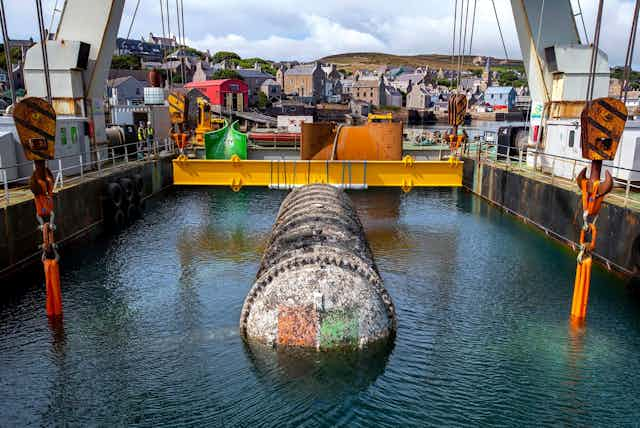Where is the text you’re reading, right now? In one sense, it lives “on the internet” or “in the cloud”, just like your favourite social media platform or the TV show you might stream tonight.
But in a physical sense, it’s stored and transmitted somewhere in a network of thousands of data centres across the globe. Each of these centres is whirring, buzzing and beeping around the clock, to store, process and communicate vast amounts of data and provide services to hungry consumers.
All this infrastructure is expensive to build and run, and has a considerable environmental impact. In search of cost savings, greater sustainability and better service, data centre providers are looking to get their feet wet.
Tech giant Microsoft and other companies want to relocate data centres into the world’s oceans, submerging computers and networking equipment to take advantage of cheap real estate and cool waters. Is this a good thing? What about the environmental impact? Are we simply replacing one damaging practice with another?
Which companies are doing this?
Microsoft’s Project Natick has been pursuing the idea of data centres beneath the waves since 2014. The initial premise was that since many humans live near the coast, so should data centres.
An initial experiment in 2015 saw a small-scale data centre deployed for three months in the Pacific Ocean.
A two-year follow-up experiment began in 2018. A total of 864 servers, in a 12 by 3 metre tubular structure, were sunk 35 metres deep off the Orkney Islands in Scotland.
Microsoft is not the only company experimenting with moving data underwater. Subsea Cloud is another American company doing so. China’s Shenzhen HiCloud Data Center Technology Co Ltd has deployed centres in tropical waters off the coast of Hainan Island.
Why move data centres under the waves?
Underwater data centres promise several advantages over their land-locked cousins.
1) Energy efficiency
The primary benefit is a significant cut in electricity consumption. According to the International Energy Agency, data centres consume around 1–1.5% of global electricity use, of which some 40% is used for cooling.
Data centres in the ocean can dissipate heat in the surrounding water. Microsoft’s centre uses a small amount of electricity for cooling, while Subsea Cloud’s design has an entirely passive cooling system.
2) Reliability
The Microsoft experiment also found the underwater centre had a boost in reliability. When it was brought back to shore in 2020, the rate of server failures was less than 20% that of land-based data centres.
This was attributed to the stable temperature on the sea floor and the fact oxygen and humidity had been removed from the tube, which likely decreased corrosion of the components. The air inside the tube had also been replaced with nitrogen, making fires impossible.
Another reason for the increased reliability may have been the complete absence of humans, which prevents the possibility of human error impacting the equipment.
3) Latency
More than one third of the world’s population lives within 100 kilometres of a coast. Locating data centres close to where people live reduces the time taken for data to reach them, known as “latency”.
Offshore data centres can be close to coastal consumers, reducing latency, without having to pay the high real-estate prices often found in densely populated areas.
4) Increased security and data sovereignty
Moving data centres into the ocean makes them physically more difficult for hackers or saboteurs to access. It can also make it easier for companies to address “data sovereignty” concerns, in which certain countries require certain data to be stored within their borders rather than transmitted overseas.
5) Cost
Alongside savings due to reduced power bills, fewer hardware failures, and the low price of offshore real estate, the way underwater data centres are built may also cut costs.
The centres can be made in a modular, mass-produced fashion using standardised components, and shipped ready for deployment. There is also no need to consider the comfort or practicality for human operators to interact with the equipment.
What about the environmental impact?
At present there is no evidence placing data centres in the world’s oceans will have any significant negative impact. Microsoft’s experiments showed some localised warming, but “the water just metres downstream of a Natick vessel would get a few thousandths of a degree warmer at most”.
The Microsoft findings also showed the submerged data centre provided habitat to marine life, much like a shipwreck:
[…] crabs and fish began to gather around the vessel within 24 hours. We were delighted to have created a home for those creatures.

If underwater data centres go ahead, robust planning will be needed to ensure their placement follows best practise considering cultural heritage and environmental values. There are also opportunities to enhance the environmental benefits of underwater data centres by incorporating nature-positive features in the design to enhance marine biodiversity around these structures.
What’s next?
Several companies are actively exploring, or indeed constructing, underwater data centres. While the average end-user will have no real awareness of where their data are stored, organisations may soon have opportunities to select local, underwater cloud platforms and services.
Companies with a desire to shout about their environmental credentials may well seek out providers that offer greener data centres – a change that is likely to only accelerate the move to the ocean.
So far, it looks like this approach is practical and can be scaled up. Add in the environmental and economic savings and this may well be the future of data centres for a significant proportion of the planet.
Read more: We are ignoring the true cost of water-guzzling data centres

